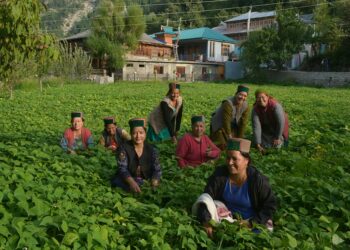By Prof RAJESHWAR SINGH CHANDEL, EXECUTIVE DIRECTOR, PRAKRITIK KHETI KHUSHHAL KISAN YOJNA, HP
ASHISH GUPTA, CONSULTANT, PRAKRITIK KHETI KHUSHHAL KISAN YOJNA
Agriculture contributes upto 45 percent to the state GDP in the Indian Himalayan region of Himachal. Fruit cultivation, especially apple, has proved to be an economic boon, and is the mainstay of over 1.7 lakh families. This is not only the economic backbone of the people, but also supports thousands of allied agricultural occupations. This image of the state also positively contributes to the tourism sector. Whereas, the average per capita income of an individual in Himachal Pradesh has reached a heathy level, this monetary prosperity has come at a great cost to the environment and health of people and animals of the state.
The excessive and indiscriminate use of pesticides and agro-chemicals, to increase crop production, has had a detrimental impact. Studies have shown that excessive use of chemical fertilizers and pesticides has had adverse impact on the soil, productivity, biodiversity and human health of the region. This has also resulted in huge input costs to farmers who now depends on external inputs and thus put their income security at risk. It is also true that farmers growing hardy and nutritious traditional crops such as mountain millets (Foxtail, Proso, Barnyard etc.), myriad other mountain folk-rice varieties (Chohartu, Jareti, Lal dhan, kali jhini, Bhrigu dhan etc.), pseudo-cereals (like Amaranth and Buckwheat etc.) are diminishing to the extent of it becoming difficult to find traditional cuisines based on these crops. Grains like Quinoa, Chia and Emmer wheat are growing in popularity in India when such similar grains existed in Himachal Pradesh for centuries. This loss of diversity is alarming and warrants a systemic change in agricultural production.

In addition to loss of agro-biodiversity, there are the issue of soil health, as well as the health of farmers, consumers and animals. As per published reports, around 10,000 pesticide poisoning cases are reported every year in India. Also, within Himachal Pradesh, more than 80 per cent of the farmers observed a decrease in productivity and 94.51 percent observed an increase in cost of production, based upon a scientific study. This has been established as one of the major reasons which is alienating mountainous folks from their family venture of farming. These have led to a point, where a new paradigm is needed to change the fundamental structure of agriculture in Himachal Pradesh to make it more food secure and sustainable. This situation has led to the creation of the Movement of Natural Farming to ensure Sustainable benefits – ecological, economic and social for the entire state.
Such a paradigm is visioned by an innovative system of Natural Farming. Originally promoted by well-known senior agriculturist from Maharashtra and Padmashri recipient – Subhash Palekar, in the mid-1990s as an alternative to the Green Revolution’s methods.
Subhash Palekar Natural Farming (SPNF) is a holistic alternative to the conventional system of high-cost chemical inputs-based agriculture. SPNF is a farming practice that believes in natural growth of crops without adding any agro-chemicals or any other ex-situ inputs. Farmers practice agriculture with lower input cost and thus, have better capacity to increase their income. At the same time, the Natural Farming system helps in enhancing fertility of depleted soil and is climate change resilient. The farmers become self-reliant with production on in-situ inputs based on their geographical natural resources. This method requires only one indigenous cow for 30 acres of land, which is suitable to Himachal, since land holdings are small as compared to other states. This farming technique harmonises the principles of Agroecology, based on the latest scientific discoveries in agriculture, and at the same time, it is rooted in Indian tradition. It also encourages farmers to preserve traditional crop varieties, since these are hardy and also help retain our traditional cuisine systems, besides enhancing food security.

In April 2018, the United Nations urged all countries to move towards the adoption of Agroecology to meet the twin goals of global food security and conservation of the environment. In addition, the implementation of Sustainable Development Goals (SDGs) require programs which reduce risk, promote ecological development and income enhancement systems for smallholders. This system is aligned with such goals and shows that it is futuristic from a sustainability point of view. Interestingly one of the SDGs 8.9 states: “By 2030, devise and implement policies to promote sustainable tourism that creates jobs and promotes local culture and products” falls inline with these ideals of SPNF. Goals such as these are enablers in ushering new paradigms on agro-ecotourism as well.
In January 2018, the Government of Himachal Pradesh announced ‘Prakritik Kheti Khushal Kisan (PK3) Yojana’ (Prosperous Farmer through Natural Farming), a new Scheme based on the principles of Natural Farming to trigger a pro-nature sustainable movement. As of July 2020, 74,202 farmers practicing SPNF are supported in this program across the state through the scheme. This evinces Natural Farming as a sustainable agro-ecological practice that has potential to minimise cost of cultivation, sustain soil fertility, reduce water requirement and enhance farmers’ income. It also bolsters a positive image to our ecologically sensitive mountain state in preserving its environment and traditional systems. Surely, this will have a positive impact on tourism too, wherein tourists will be safe and confident in visiting the state, partaking in farming activities and consuming safe food free from harmful chemical residues.

Going forward, there is a vision to create innovative market linkage mechanisms for PK3 farmers. New benchmarks on Sustainable Food Systems including fair price accounting, transparency between farmers and consumers, creation of formal models such as FPOs and Information Technology are proposed to be used to create a truly modern and globally connected model of agriculture. For the youth of Himachal who are impacted during the COVID lockdown, new avenues will be created in the sectors of agriculture, value chains and eco-tourism going forward. Thus, this program has a potential to positively impact livelihoods of the mountainous people.
The true spirit of the mountain and its people will be visible systemically. Such change is unprecedented in India and will truly make the people of this Himalayan state proud of their heritage.
All these models shall have a positive linkage with tourism, where travellers will be able to enjoy not just the view of the misty mountains but also connect with the true culture of agriculture! It is not hard to imagine that one day tourists/ trekkers will like to visit and farm-stay with such natural farmers to know more about such techniques and enjoy traditional meals full of nutrition and tastes.
Countries in Europe (e.g. in the Alps) and America (e.g. in Aspen) are known for their Wine and Cheese. Similarly, Himachal and its culture is deeply connected to its food, many customs, music and deities, all of which is integrally linked to this culture of agriculture. The ambitious initiative of the state government to redesign and prioritize Sustainable Agriculture by ecosystem restoration is an ambitious and long term program. The successful implementation strategies for implementation of PK3, the dream project of the Himachal Pradesh Government, through adoption of SPNF have shown potential to achieve positive socio-ecological benefits.

This mission of converting this mountainous state into a Natural Farming State will positively contribute to Sustainable Tourism. Sale of products derived from indigenous natural resources shall also provide significant opportunities for income-generation and employment. This symbiotic relationship between tourism and natural agriculture will certainly promote Sustainable Farm-stays, a state of the art version of home-stays. It will help trekkers and tourists view rural Himalayan areas in a new light. Cultural Exchanges, Natural Farm walks, partaking in farming practices without any worry of health, rural animal husbandry and transhumance are some of the various activities which can dovetail into showcasing the true Mountain Culture.
With a revival of indigenous crops alongside modern farming systems, it is not hard to imagine a time when Himachal Pradesh will be known for its rich gastronomical trails too. A truly sustainable experience is unravelling in Himachal Pradesh and invites all – producers and consumers to partake in. Come Join Us in this exciting journey!

Founded in 2016, The Traveller Trails is a print and digital magazine and a trusted source for current news, trends, analysis, opinions, interesting blogs, videos and exclusive interviews from every corner of the world.












